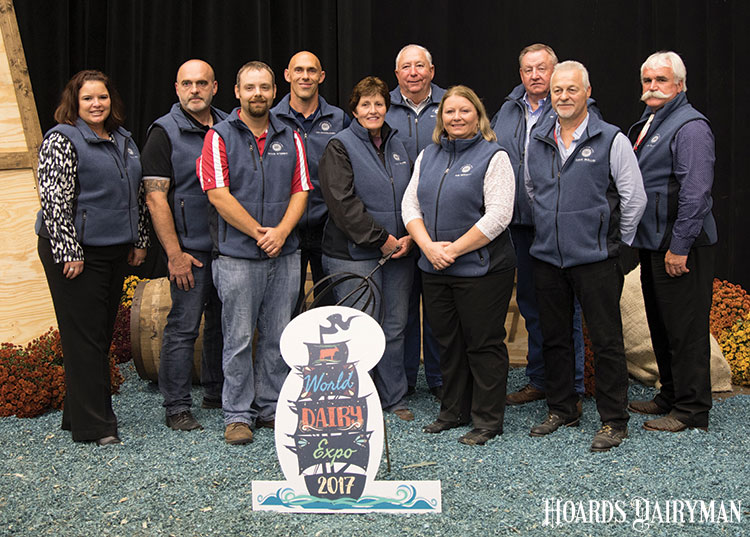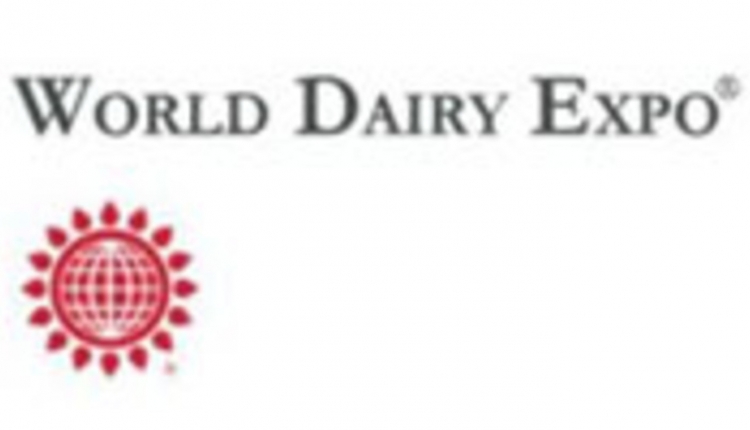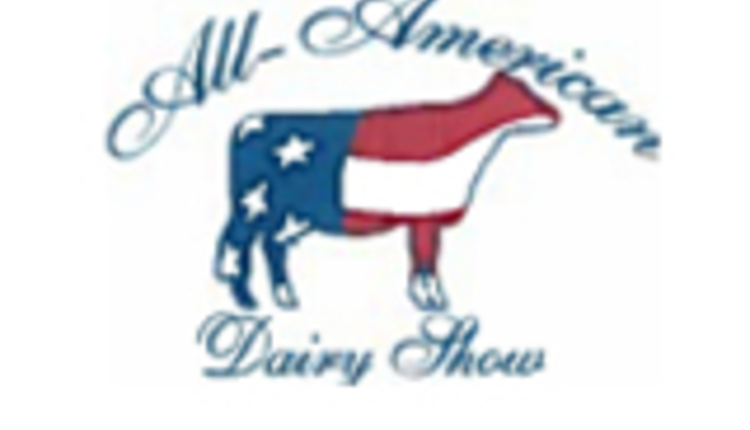
Ken Elliott may not have been born in Wisconsin, or even the U.S. for that matter. However, once he arrived in the Badger State in 1995, he fully embraced his newfound home in America’s Dairyland. Within two years of establishing his family’s Partee Holstein and Jersey herd, World Dairy Expo leaders began asking for Elliott’s help.
“Pat O’Brien had stopped by my farm on his routine semen route,” recalled Elliott of a conversation in 1997.
“Could you help me out with the Jersey show?” O’Brien asked. After some careful consideration, Elliott agreed to help O’Brien, and he began checking in Jersey cattle onto the show grounds by confirming registry and ownership status. The volunteer role went on for about three years. That’s when Elliott received a call from W. Terry Howard, a longtime extension specialist in the University of Wisconsin-Madison’s Dairy Science Department.
A call from an Expo legend
Howard had been involved with World Dairy Expo since the word “Go.” Not only had Howard been the show’s longest tenured person to serve as Holstein breed superintendent at that time, but he had also served stints as the breed superintendent for both the Brown Swiss and Guernseys. And, in 1989, the former University of Nebraska basketball player, who once guarded the legendary Wilt Chamberlain, had taken over the leadership reins from another legend . . . “Doc Jim,” as in the legendary University of Wisconsin-Madison faculty member Jim Crowley, who guided World Dairy Expo for 20 years as its Overall Breed Superintendent.
Howard, who had been leading the entire cattle show for 12 years when he placed that call in 2000, must have seen something special in Elliott.
“Terry called me one day,” recalled Elliott. “He said, ‘Al Wollenzien would like to retire from serving as Holstein superintendent. Would you be interested in the role?’”
Howard gave his pitch and left Elliott with some time to ponder the decision. This was far different than the 1967 decree Doc Jim leveled to a much younger Howard when he said, “You will be involved!”
“I talked to a few close friends, and everybody told me it would be a good idea to take on the role. And that is what I did,” said Elliott of that 2000-era phone call to his Marshall, Wis., farm residence.
“I pretty much jumped right in that first year,” said Elliott. “Working for Terry Howard was pretty positive,” he went on to say. “Terry had his own way of doing things. I learned a lot.”
After Howard retired from the role, Elliott went on to work for three additional overall breed superintendents — Bob Kaiser, Jim Crowley Jr., and Dave Bollig. In working with the latter two individuals, Elliott not only served as Holstein breed superintendent, but as assistant superintendent of the entire cattle show, as well. In fact, Elliott has become the second-longest tenured person to serve in that assistant role next to Jim Crowley Jr., the son of legendary “Doc Jim.”
“That’s when I began talking back and forth quite a bit more with the cattle show to go over the game plan,” he said of communication with the World Dairy Expo brain trust in his added role of assistant cattle superintendent. “You also get to be a bit of the mentor to the superintendents that come in after you.”
A strong and diverse background
What did Howard see in Elliott that caused his name to be placed on top of the list? The Canadian’s life experiences may help answer that question.
Elliott graduated from the University of Guelph and its Ridgetown College in 1978. He then went to work for Paperman Farm in nearby Woodstock, Ontario, Canada. From there, Elliott went to Doug Wingrove’s Allangrove Farm in rural Guelph. While Elliott never made it to World Dairy Expo while caring for the Allangrove herd, Wingrove did show Holsteins on a number of occasions at the Madison, Wis., show. As those experiences took place, Elliott stayed back and took care of the home herd.
Eventually, Wingrove sold his farm and a majority of the herd to Oscar Dupasquier in 1984. The Swiss immigrant, who purchased the Holsteins, went on to eventually claim Premier Breeder seven straight years at World Dairy Expo from 1993 to 1999.
A few years before that farm sale, Elliott had already turned his eyes west and headed stateside to California’s Pacific Coast.
“I went to work for Ocean View Farms, Windsor, Calif., and Marvin Nunes. That’s when I met Kathy, and the rest is history,” Elliott said of the combination of working for the well-known Holstein herd and also meeting the love of his life.
As it turned out, 1984 became a pivotal year in Elliott’s life for a number of reasons.
“It’s an easy year to remember,” chuckled Elliott. “That’s the year I got married.”
The year the couple married, Ken also got to attend his very first World Dairy Expo and saw the famed colored shavings that also debuted that year.
After managing Duarte-Acres for one decade, Ken moved his young family to Wisconsin to get out on their own.
“To me, at that point of time, I didn’t want a large herd. It just didn’t work for me,” said Elliott. “This (Wisconsin) was the only place we could come. We did look in Canada, too, but the prices up there due to quota made it look like it would be a lot tougher to make it go.
“My wife, Kathy, and Mary (Piper) Finley were real good friends. So, Alvin (Mary’s father) was the one who helped me out,” he said about finding the farm in 1995.
As it turned out, that farm had a number of additional World Dairy Expo connections.
“Actually, Ray Kuehl was the realtor for our farm,” recalled Elliott of that purchase. “The farm was previously owned by R. Dale Jones.”
Kuehl and Jones were another pair of World Dairy Expo initiators. Kuehl was tending to the Crescent Beauty show string the very night Allen Hetts proclaimed to confidants at the Kit Kat Klub in Waterloo, Iowa, “We need a show!” He went on to lay the groundwork for what became World Dairy Expo.
Jones also was an early show organizer and helped convince Canadians to bring show strings to the fledging event. “R. Dale would frequently go up to Canada where he’d meet with the likes of Doug Wingrove, Bert Stewart, and others,” Elliott said.
Was it chance or fate that Ken Elliott was eventually chosen to head the Holstein show?
It appears a good dose of fate was involved in the journey.
The “super role”
So, what does Elliott do at the show in this position?
The superintendents meet about two weeks before the event. “We get our information from the office, which includes entries and stalling requests. We then go through the information as a group of superintendents and sort through any forms that may belong to another breed,” said Elliott of the process to onboard what becomes one of the nation’s largest dairy herds . . . and certainly the most valuable.
“Then, we take our materials home and start putting the puzzle together,” stated Elliott. “We know going into this that we don’t have enough room because we generally get in the 3,000-range of entries. We can only house 2,300 to 2,400 head of cattle.
“We then find out where that shrink is from entries. To do that, we are probably in contact with the majority of the exhibitors to try to get firm numbers,” said the longtime leader for Expo’s largest breed show.
“Generally, on the Wednesday before the show, we meet as a group of superintendents to put the stalling on the big boards. We scratch our heads to determine if we have enough room or if we don’t have enough room. Then we determine what to do about the situation.
“Now, I’m in the beef business a little bit,” Elliott said of his transition from dairy to beef farming. “What the beef cattle sector does for stalling at shows is ‘total number of feet and divide it by the total number of cattle.’ That’s how much space you get.
“Well, that doesn’t work so well with dairy cows. Beef cattle are all about the same size. Plus, you don’t have to worry about udders getting stepped on,” he explained.
“On Thursday, the early strings come onto the grounds from the longest travel distances. Then we get those strings settled in,” Elliott continued, rattling out the game plan, having the process firmly committed to his memory.
“On Friday morning, all hell breaks loose!” he said of the massive influx of cattle.
“We work as a bunch. You have to work together,” he said of the superintendents and veterinary team that checks in and stalls cattle.

Everything changed
The process that takes place to stall cattle evolved once the pavilions were opened in 2014.
“The old barns were a little different. You kind of had your area as a breed superintendent and you used it to the best of your ability,” recalled Elliott.
“With the new pavilions, I personally think it’s a little tougher as a breed superintendent because there is no such thing as a bad spot anymore. It’s just the distance from your string to the showring,” he said. “The new pavilions are definitely a step up.”
Generally speaking, move in goes rather well.
“It’s challenging some days, but for the most part it’s pretty good,” said Elliott. “I have learned this, however. If the weather is good, the stalling will go well. If the weather is bad, stalling doesn’t go as well because people aren’t necessarily in a good mood. But you can’t control the weather.
“Once we get the exhibitors and cattle stalled on the grounds, we can turn our larger volunteer crews loose to check entry and registration papers,” Elliott said of the role he started back in 1997. “Once cattle are stalled and checked in, I continually go through the pavilions talking to exhibitors, listening to the issues that they bring up. It’s at this time that fellow superintendents help out with other breeds, too,” said the man who truly enjoys working behind the scenes to make the engine purr to perfection.
As for nuances to the breed show he manages, “Holsteins are the only breed that publish its Cattle Log after check in. All the other Cattle Logs are printed before cattle arrive on the grounds,” noted Elliott of the printed show books placed in the Coliseum. “That’s why we don’t have quite as many scratches in the Holstein Cattle Log. Generally, we have that done by Wednesday at noon. Then we send it to the printer and have it back on Thursday in time for the Holstein breed meeting. At the meeting, we hand out back tags and make show-related announcements.”
Then on Friday, the show starts.
“Since we hadn’t started the show at noon for many years, we backed the start time to 1 p.m.,” he said of another recent change. “Once the cattle start getting into the ring, it’s pretty smooth sailing, not too much comes up.
“Once exhibitors get into the ring, it’s serious!” he added of the final breed show.
A unique perspective
“A lot of people think I have the greatest seat on the grounds,” he said of ribbing he’s gotten over the years. “But try sitting there all day! It gets pretty long, considering our week started the prior Wednesday,” he stated, almost oozing exhaustion from his voice. “You do get to see the cow from a different perspective,” he said with admiration.
“After the Holstein champion is named, I also have helped out with Supreme Champion for the past 20 years by helping to collect and tabulate ballots.”
As for the biggest show improvement, Elliott was quick to point out, “What we did with the ethics. Maybe at the time we didn’t think so, but it forced us to breed a better cow. The mammary systems on these cows nowadays are phenomenal. In a previous era, you’d hear people say, ‘Give me a frame and I’ll make the cow.’ Nowadays, these cows are so good in the udder!”
Overall, Elliott prides himself in focusing on the exhibitors.
“I try to do what’s in the best interest of the exhibitor. They may not think that at the time. But oftentimes, exhibitors have come back and thanked me if we had a disagreement.
“It’s been very rewarding doing this. You need to roll with the ‘punches’ a bit. You can’t get too worked up too fast,” continued Elliott.
After more than 20 years, Elliott has made the decision to retire from the role due to health reasons. Looking back, he fondly remembers the people he’s worked with all these years.
“Dairy cattle exhibitors are a unique bunch but they are a good bunch.”










